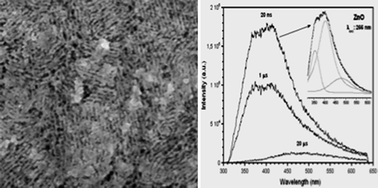Nanocasted mesoporous nanocrystalline ZnO thin films
Abstract
For the first time the formation of photoluminescent mesoporous

* Corresponding authors
a
1Chimie de la Matière Condensée de Paris, UMR UPMC-CNRS 7574, Université Pierre et Marie Curie (Paris 6), Collège de France, 11 place Marcelin Berthelot, Paris, France
E-mail:
david.grosso@upmc.fr
b Dpto. Química Inorgánica y Orgánica, Universidad Jaume I, Avda. Sos Baynat, s/n, Castellón, Spain
c Institute of Biophysics and X-ray Structure Research, Austrian Academy of Sciences, Steyrergasse 17/VI, Graz, Austria
d Center for Functional Materials, Department of Physical Chemistry, Åbo Akademi University, Porthansgatan 3-5, Turku, Finland
For the first time the formation of photoluminescent mesoporous

 Please wait while we load your content...
Something went wrong. Try again?
Please wait while we load your content...
Something went wrong. Try again?
S. Lepoutre, B. Julián-López, C. Sanchez, H. Amenitsch, M. Linden and D. Grosso, J. Mater. Chem., 2010, 20, 537 DOI: 10.1039/B912613A
To request permission to reproduce material from this article, please go to the Copyright Clearance Center request page.
If you are an author contributing to an RSC publication, you do not need to request permission provided correct acknowledgement is given.
If you are the author of this article, you do not need to request permission to reproduce figures and diagrams provided correct acknowledgement is given. If you want to reproduce the whole article in a third-party publication (excluding your thesis/dissertation for which permission is not required) please go to the Copyright Clearance Center request page.
Read more about how to correctly acknowledge RSC content.
 Fetching data from CrossRef.
Fetching data from CrossRef.
This may take some time to load.
Loading related content
